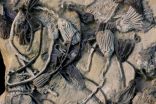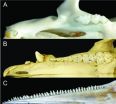(Press-News.org) COLUMBUS, Ohio—Though scientists have long believed that complex organic molecules couldn't survive fossilization, some 350-million-year-old remains of aquatic sea creatures uncovered in Ohio, Indiana, and Iowa have challenged that assumption.
The spindly animals with feathery arms—called crinoids, but better known today by the plant-like name "sea lily"—appear to have been buried alive in storms during the Carboniferous Period, when North America was covered with vast inland seas. Buried quickly and isolated from the water above by layers of fine-grained sediment, their porous skeletons gradually filled with minerals, but some of the pores containing organic molecules were sealed intact.
That's the conclusion of Ohio State University geologists, who extracted the molecules directly from individual crinoid fossils in the laboratory, and determined that different species of crinoid contained different molecules. The results will appear in the March issue of the journal Geology.
William Ausich, professor in the School of Earth Sciences at Ohio State and co-author of the paper, explained why the organic molecules are special.
"There are lots of fragmented biological molecules—we call them biomarkers—scattered in the rock everywhere. They're the remains of ancient plant and animal life, all broken up and mixed together," he said. "But this is the oldest example where anyone has found biomarkers inside a particular complete fossil. We can say with confidence that these organic molecules came from the individual animals whose remains we tested."
The molecules appear to be aromatic compounds called quinones, which are found in modern crinoids and other animals. Quinones sometimes function as pigments or as toxins to discourage predators.
Lead author Christina O'Malley, who completed this work to earn her doctoral degree, first began the study when she noticed something strange about some crinoids that had perished side by side and become preserved in the same piece of rock: the different species were preserved in different colors.
In one rock sample used in the study, one crinoid species appears a light bluish-gray, while another appears dark gray and yet another more of a creamy white. All stand out from the color of the rock they were buried in. The researchers have since found similar fossil deposits from around the Midwest.
"People noticed the color differences 100 years ago, but no one ever investigated it," O'Malley said. "The analytical tools were not available to do this kind of work as they are today."
O'Malley isolated the molecules by grinding up small bits of fossil and dissolving them into a solution. Then she injected a tiny sample of the solution into a machine called a gas chromatograph mass spectrometer. The machine vaporized the solution so that a magnet could separate individual molecules based on electric charge and mass. Computer software identified the molecules as similar to quinones.
Then, with study co-author and Ohio State geochemist Yu-Ping Chin, she compared the organic molecules from the fossils with the molecules that are common in living crinoids today. Just as the researchers suspected, quinone-like molecules occur in both living crinoids and their fossilized ancestors.
Though different colored fossils contained different quinones, the researchers cautioned that there's no way to tell whether the quinones functioned as pigments, or that the preserved colors as they appear today were similar to the colors that the crinoids had in life.
Part of why the crinoids were so well preserved has to do with the structure of their skeletons, the researchers said. Like sand dollars, crinoids have skin on top of a hard calcite shell. In the case of crinoids, their long bodies are made up of thousands of stacked calcite rings, and each ring is a single large calcite crystal that contains pores filled with living tissue. When a crinoid dies, the tissue will start to decay, but calcite will precipitate into the pores, and calcite is stable over geologic time. Thus, organic matter may become sealed whole within the rock.
"We think that rock fills in the skeleton according to how the crystals are oriented. So it's possible to find large crystals filled in such a way that they have organic matter still trapped inside," Ausich said.
The location of the fossils was also key to their preservation. In the flat American Midwest, the rocks weren't pushed up into mountain chains or heated by volcanism, so from the Ohio State geologists' perspective, they are pristine.
Their next challenge is to identify the exact type of quinone molecules they found, and determine how much information about individual species can be gleaned from them.
"These molecules are not DNA, and they'll never be as good as DNA as a means to define evolutionary relationships, but they could still be useful," Ausich said. "We suspect that there's some kind of biological signal there—we just need to figure out how specific it is before we can use it as a means to track different species."
INFORMATION:
This research was sponsored by the National Science Foundation and the Geological Society of America.
Contacts: Christina O'Malley, Omalley.47@osu.edu
William Ausich, (614) 292-3353; Ausich.1@osu.edu
Written by Pam Frost Gorder, (614) 292-9475; Gorder.1@osu.edu
Editor's note: images for the story are available from Pam Frost Gorder
Ancient fossilized sea creatures yield oldest biomolecules isolated directly from a fossil
2013-02-19
ELSE PRESS RELEASES FROM THIS DATE:
It's off to work we go
2013-02-19
This press release is available in French.
Montreal, February 18, 2013 – In a large city like Montreal, public transit provides us with options for getting to work or school and back home again. In deciding to choose traffic jams over metro delays, or to pay for parking rather than buy a monthly pass, you weigh the pros, cons and costs of your options, and your mental calculations are more complicated than they may appear at first glance.
In a paper recently published in The Journal of Transportation and Land Use, Zachary Patterson, an assistant professor in Concordia ...
Solar sponge' soaks up CO₂ emissions
2013-02-19
CSIRO scientists have created a 'solar sponge' which captures and then releases carbon dioxide using the power of natural sunlight.
The breakthrough presents a new way to recycle CO2 emissions using renewable energy. The 'sponge' which is made from a new smart material called a MOF - metal organic framework - adsorbs carbon dioxide, but when exposed to sunlight, instantaneously releases it.
Known as dynamic photo-switching, this capture-and-release method is extremely energy efficient and only requires UV light to trigger the release of CO2 after it has been captured ...
New evidence for link between depression and heart disease
2013-02-19
MAYWOOD, Il. - A Loyola University Medical Center psychiatrist is proposing a new subspecialty to diagnose and treat patients who suffer both depression and heart disease. He's calling it "Psychocardiology."
In his most recent study, Angelos Halaris, MD, PhD, and colleagues found that an inflammatory biomarker, interleukin-6, was significantly higher in the blood of 48 patients diagnosed with major depression than it was in 20 healthy controls. Interleukin-6 has been associated with cardiovascular disease. Halaris presented findings at a joint congress of the World Psychiatric ...
In fight against cancer, a closer look at nuclear blebbing
2013-02-19
Misshapen cell nuclei are frequently observed in the cells of people with cancer and other diseases, but what causes the abnormality -- and why it is associated with certain disorders -- has remained unclear.
Researchers at Northwestern University have recently developed a mathematical model that sheds light on the defect by clarifying the mechanisms that cause bulges known as "blebs" in cells' nuclear membranes. The research -- a collaboration between experts at the McCormick School of Engineering and Applied Science and the Feinberg School of Medicine -- could be a ...
Nesting site protection 'key to save turtles from climate change'
2013-02-19
International marine scientists today warned it will be vital to protect key marine turtle nesting grounds and areas that may be suitable for turtle nesting in the future to ensure that the marine reptiles have a better chance of withstanding climate change.
A new study reveals that some turtle populations in the West Indian Ocean, Northeast Indian Ocean, North Pacific Ocean, East Atlantic Ocean and the East Pacific Ocean are among the least likely to recover from the impacts of climate change. Mariana_19feb_2
"To give marine turtles a better chance of coping with climate ...
5-ALA fluorescence guides resection of recurrent glioblastoma multiforme
2013-02-19
Charlottesville, VA, February 19, 2013. Neurosurgeons from UC San Francisco describe the use of 5-aminolevulinic acid (5-ALA) fluorescence in guiding resection of recurrent glioblastoma multiforme (GBM). Ingestion of 5-ALA by a patient before surgery leads to fluorescence of tumor cells intraoperatively in response to certain wavelengths of light. This can provide information not necessarily available through magnetic resonance imaging (MRI), the standard mode of imaging used to detect primary and recurrent GBMs. The additional information provided by 5-ALA fluorescence ...
How the whale got its teeth
2013-02-19
Whales are mammals, but they don't look like the mammals living around us, as they have a triangular fluke for tail, no hind legs and no body hair. And inside their mouths, their teeth are unfamiliar too – being much simpler and 'peg like'. A multidisciplinary team of researchers have now married together the fossil record and the embryonic development process to investigate how the whale got its teeth.
Most mammals have four kinds of teeth, each shaped for specific tasks. In most mammals there are wedge-shaped incisors, a pointy canine, and premolars and molars with ...
Stillbirth in Inuit and First Nations women higher than for non-Aboriginal residents
2013-02-19
Stillbirth rates in First Nations and Inuit populations in Quebec are higher than in the general population, especially in late gestation and at term, found a new study in CMAJ (Canadian Medical Association Journal).
"Aboriginal populations in Canada [First Nations and Inuit] rank at the top of the list of disadvantaged groups with the highest rates of stillbirth in the Western world," writes Dr. Nathalie Auger, Institut national de santé publique du Québec, with coauthors. Rates are 2 times those of the non-Aboriginal population.
Researchers looked at data on 9983 ...
Unplanned hospitalization more likely in people with several illnesses, mental health conditions
2013-02-19
People with multiple illnesses are much more likely to be admitted to hospital unexpectedly, and mental health issues and economic hardship further increase the likelihood, according to a study in CMAJ (Canadian Medical Association Journal).
"We provide strong evidence that physical multimorbidity substantially affects the use of acute hospital services, including admissions considered potentially preventable through management of optimal primary care," writes Dr. Rupert Payne, Cambridge Centre for Health Services Research, University of Cambridge, Cambridge, United Kingdom. ...
There's room for improvement in women's heart disease awareness
2013-02-19
The number of women aware that heart disease is the leading cause of death has nearly doubled in the last 15 years, but that knowledge still lags in minorities and younger women, according to a new study in the American Heart Association journal Circulation.
Researchers comparing women's views about heart disease in 1997 and today, found:
In 2012, 56 percent of women identified heart disease as the leading cause of death compared with 30 percent in 1997.
In 1997, women were more likely to cite cancer than heart disease as the leading killer (35 percent versus 30 ...

